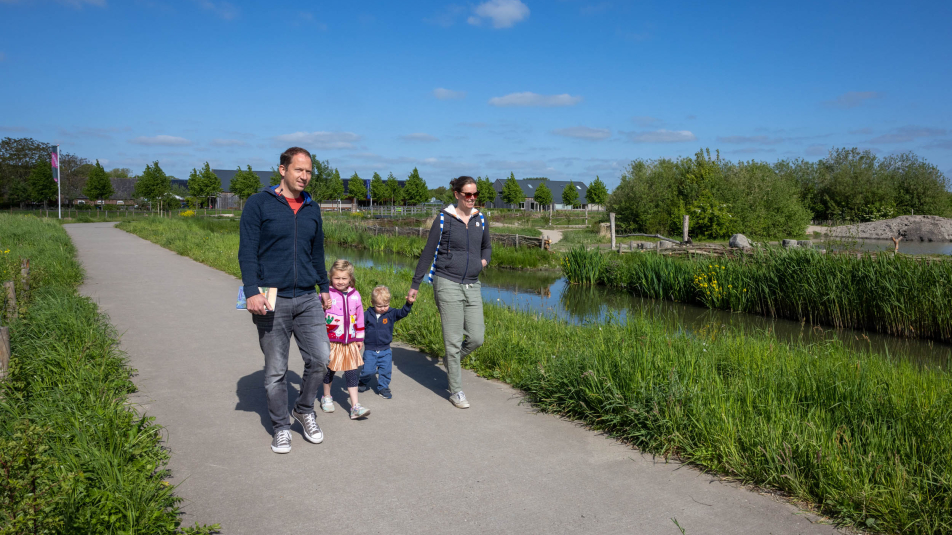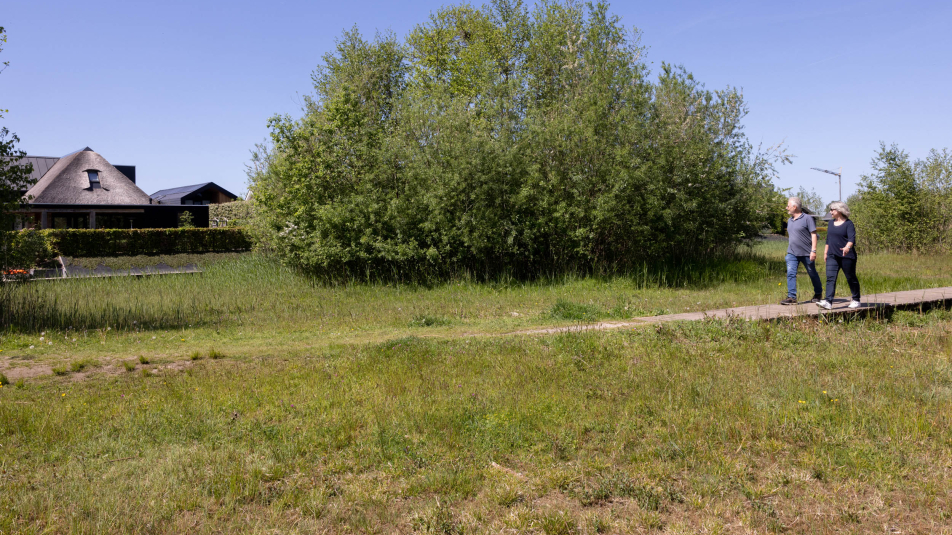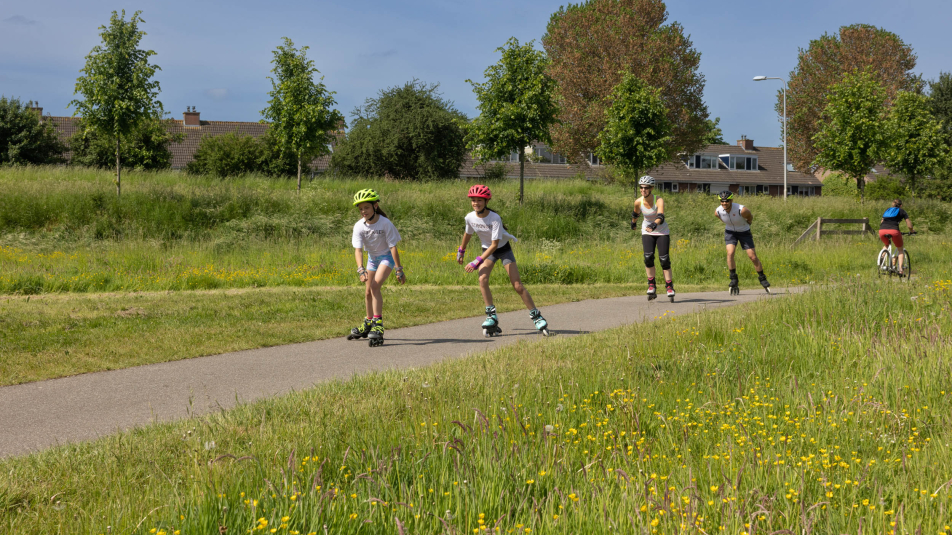More and more people want to live in the province of Utrecht. The demand for space is high and green spaces are under pressure. While green spaces are of great value for the happiness and health of residents, for climate adaptation and for biodiversity. Groen Groeit Mee is the ambition to allow recreational green spaces, waters and countryside to grow with the rising number of homes in the province of Utrecht.
In the collaborative programme Groen Groeit Mee (growing greenspace), 40 parties are working together on more and better green spaces: spaces, including waters, that are better known, more diverse and easily accessible.
Task
Green spaces comprise the quality of our region. But a healthy growth in the number of homes and workplaces is our task. How can we unify these aspects? While a concrete demand for space for homes, energy and mobility has been set, this is not yet the case for all green spaces, for the countryside and for more sustainable agriculture. And this requires change, according to the 40 Pact partners of the Groen Groeit Mee programme.
Green spaces are of great value when it comes to the health of residents, climate adaptation and biodiversity. This is the moment to include green and blue spaces in every spatial plan. That is why we, in Groen Groeit Mee, are working on a good mix of accessible green spaces, sustainable agriculture, resilient nature, countryside that is open to all and visible waters. Urbanisation and the strengthening of existing and new green spaces will be developed in connection, so that they both contribute to the spatial quality of our region as a whole.
Purpose
The purpose of Groen Groeit Mee is for green spaces to become an essential part of spatial planning, alongside homes, workplaces, mobility and energy. Groen Groeit Mee therefore also contributes to other programmes, at both the rural and urban level.
Groen Groeit Mee creates and maintains a balance between urbanisation and green spaces in the province of Utrecht. The result is a healthy living environment and an attractive business location. In the provincial environmental decree, the Province of Utrecht established that green spaces must grow in equal proportion to the construction of homes in areas of expansion that comprise over 50 homes. To help municipalities and project developers fulfil this condition, the Province of Utrecht has developed a guide for new residential areas (handreiking Groen bij uitbreidingslocaties, not available in English). In addition, we are testing how we can achieve the ambitions of Groen Groeit Mee in practice by gathering experience in four exemplary areas, together with the Pact partners. (You will find videos of two examplary areas below.)
What are green spaces?
We understand ‘green spaces’ to include the following five green values, which are also mentioned in the handreiking Groen bij uitbreidingslocaties (guide for new residential areas) as De Schijf van Vijf (the wheel of five):
- Accessible green spaces
Every resident should be able to access green areas with qualities that connect with their recreational wishes and needs. - Sustainable agriculture
The agricultural sector should be profitable while also following the principles of circular agriculture and inclusion towards nature. - Resilient nature
Nature should encompass a rich biodiversity and be resilient. - Countryside open to all
The countryside should be lively and open to all, and contribute to distinctive heritage and culture. - Visible waters
A robust and visible water system should contribute to healthy urban life, nature and agriculture.
Groen Groeit Mee focuses on green spaces and countryside areas around cities and towns and in urban fringe zones, and on interconnecting strips and green or blue networks between built-up areas. Green spaces within cities and towns fall outside the scope of Groen Groeit Mee.
Our tasks in focus
The tasks regarding countryside areas, waters and green spaces around the U10 network organisation, the Amersfoort region, the Utrecht part of the food valley region and the four water boards are mapped out in the report Groen Groeit Mee, Opgaven in beeld (Tasks mapped out, not available in English). This task inventory is subdivided into 13 so-called key units.
13 key units
- New recreational areas
- Recreational connections with green spaces and ecological design
- Recreational connections
- Recreational networks through agricultural areas
- Green outline areas
- New nature hubs
- Ecological connections
- Recovery of heritage planting/small landscaping elements
- Lively field ditches
- Green or blue networks through agricultural areas
- New large-scale artistic infrastructure
- Outer gateways
- Space for growing water tasks
Further explanation is included in paragraph 2.2 of the report (not available in English).
To further specify the Groen Groeit Mee tasks, linked to the task of urbanisation, a Groen Groeit Mee brochure (not available in English) has been drafted with discussion cards. The brochure with discussion cards includes an outline of potential green projects (including a cost estimation) that contribute to national, provincial and local goals in the areas of water, climate, nature, agriculture, healthy urbanisation and recreation, among others. The brochure marks the first exploration of a snapshot of the possible implementation of future green or blue projects linked to the urbanisation task to construct 165,000 homes, on the basis of the available documentation and visions.
Groen Groeit Mee funding
One of the main questions regarding Groen Groeit Mee is the funding of its green ambitions: who is going to pay for that, and from which funding sources? Although the societal importance of green spaces is broadly embraced, finding financial resources to invest in and manage green spaces is a considerable challenge. Our funding research from 2021 (not available in English) offers insights into the possible funding forms, sources and implementation tools to achieve the green ambitions of Groen Groeit Mee.
For investments in nature, parties often look towards the government or countryside management organisations. But to really allow green and blue spaces to grow with us, the task must be embedded to a much greater extent within regular investment processes in (integrated) area development projects – including by businesses and by citizens. The value of nature for humans is self-evidently positive. This became even more clear during the lockdowns under the coronavirus pandemic. The budgeting and funding strategy (not available in English) of Groen Groeit Mee links this value to funding sources and mechanisms that allow for joint investment in recreational green spaces and waters.
Also interesting
-
Haarzuilens Estate: planning and designing a high-quality recreational landscape
Just outside the city of Utrecht, to the north-west of Vleuten-De Meern, lies the 400-hectare recreation and nature area known as ‘Landgoed Haarzuilens’ (Haarzuilens Estate).
-
New nature area De Groene Grens creates ecological buffer
A new nature and recreation area, De Groene Grens, is being developed on the boundary between Veenendaal and Ede. The area consists of a long, linear series of nature sites and forms an ecological green buffer between the two municipalities.
-
Video Hollandsche IJssel area
To test the ambitions of Groen Groeit Mee in practice we are gathering experience in four exemplary areas. Hollandsche IJsselgebied is one of these exemplary areas.
The Province of Utrecht, municipalities of IJsselstein, Nieuwegein, Montfoort and Utrecht, the national forestry and De Stichtse Rijnlanden water board are working on the Hollandsche IJssel case.
-
Video Kromme Rijn area
To test the ambitions of Groen Groeit Mee in practice we are gathering experience in four exemplary areas. Kromme Rijn area is one of these exemplary areas.
De Stichste Rijnlanden water board, the Province of Utrecht and the municipalities of Nieuwegein, Houten, Utrecht, Bunnik and Zeist are working on the Kromme Rijn case.



